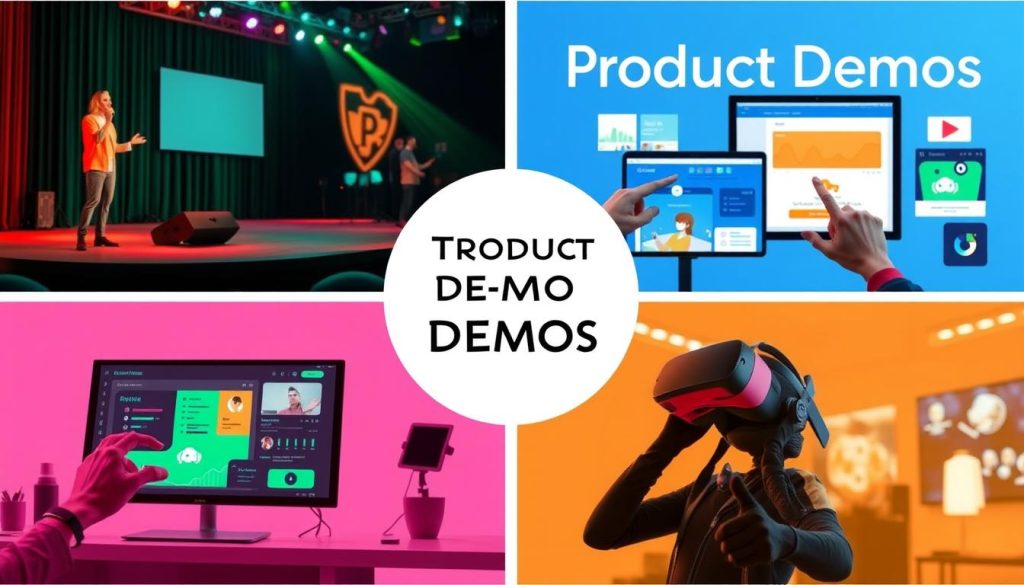Software developers need to showcase their products effectively. Product demos are a powerful tool for this purpose. They allow potential customers to experience the software’s features firsthand.
This guide explores strategies for promoting software through engaging product demos. We’ll cover key elements of successful demos and how to leverage various platforms.
You’ll learn to immerse potential customers in your software’s capabilities. This approach drives user engagement and boosts conversions.
Key Takeaways
- Product demos are a powerful tool for showcasing your software’s features and capabilities to potential customers.
- Crafting a compelling narrative and understanding your target audience are essential for creating effective product demos.
- Leveraging social media platforms, optimizing demo content for search engines, and partnering with influencers can amplify the reach and impact of your product demos.
- Incorporating product demos into your website and utilizing video hosting platforms like YouTube and Vimeo can enhance the user experience and drive conversions.
- Tracking key metrics such as engagement, conversion rates, and lead generation can help you measure the success of your product demo efforts and refine your strategies.
What is a Product Demo?
A product demo showcases software to potential customers. It offers a hands-on experience of a product’s features and benefits. This interactive approach helps businesses highlight their solution’s value and stand out from competitors.
Definition and Benefits
A product demo presents software in action, live or pre-recorded. It aims to show how the product solves problems for its target audience.
Product demos offer several advantages. They improve understanding of product features and boost conversion rates. They also engage customers and set the product apart from competitors.
Additionally, demos provide valuable feedback from potential customers. This insight can help refine the product and marketing strategies.
- Increased understanding of the product’s features and capabilities
- Improved conversion rates by demonstrating the product’s value
- Enhanced customer engagement and interactivity
- Differentiation from competitors through a personalized showcase
- Valuable feedback and insights from potential customers
Types of Product Demos
Software companies can use various types of product demos. Each type has its own strengths and best uses.
- Live Demos: These are real-time, interactive presentations where a sales representative or product expert guides the audience through the product’s features and functionalities.
- Pre-Recorded Videos: Professionally produced videos that showcase the product in action, often highlighting specific use cases or customer success stories.
- Interactive Walkthroughs: Web-based interactive experiences that allow users to explore the product’s interface and functionality at their own pace.

Understanding these demo types helps create effective product promotion strategies. Companies can choose the best approach to engage their target audience.
Preparing for a Successful Product Demo
Creating a compelling product demo requires careful planning. It’s crucial to understand your target audience deeply. By researching customer needs, you can develop a demo that truly connects with potential buyers.
Understanding Your Audience
Know your target audience before planning your demo. What challenges do they face? What features interest them most? Answering these questions helps tailor your demo to their specific needs.
This approach makes your presentation more impactful and memorable. It shows you understand their unique situation and can offer real solutions.
Crafting a Compelling Narrative
After understanding your audience, craft an engaging story for your demo. Focus on how your software solves problems and improves lives. Don’t just list features.
Use relatable examples and relevant use cases. Include eye-catching visuals to bring your narrative to life. This strategy will captivate your audience more effectively.
A successful demo shows real-world value, not just technical features. By preparing for product demos, understanding your target audience, and creating a compelling demo narrative, you’ll boost your software’s appeal.

| Key Considerations for Preparing a Successful Product Demo |
|---|
|
“The key to a successful product demo is to create a narrative that resonates with your audience and demonstrates the true value of your software.”
Good demo preparation helps you communicate your software’s benefits effectively. This approach can lead to more conversions and help you reach your marketing goals.
How To Promote Software Through Product Demos
Leveraging Social Media Platforms
Social media is a powerful tool for promoting software and product demos. It helps you reach a wider audience and showcase your software’s features effectively. You can highlight your product’s key functionalities across various platforms.
YouTube is great for creating engaging video demos. Share these videos on your social channels to boost engagement. Optimize video titles and descriptions for better search visibility.
LinkedIn is perfect for connecting with industry peers and potential customers. Share your demos on your company page or in relevant groups. This can spark discussions and generate interest from your target audience.
Facebook and Instagram are ideal for visual product showcases. Use eye-catching images and short video clips to grab followers’ attention. These platforms help you display your product in action.
Craft compelling stories when promoting demos on social media. Use interactive features like live streams or Q&A sessions. Engage with your audience to build trust and foster long-lasting relationships.

“Harnessing the power of social media for product demos can be a game-changer in the world of software promotion.”
Optimizing Demo Content for Search Engines
Optimize your product demos for search engines to boost visibility. This will help your target audience find your demos easily. By using SEO strategies, you can attract more potential customers.
Keyword research is crucial for optimizing demo content. Find phrases your audience uses when searching for product demos. Use these keywords in video titles, descriptions, and tags.
Pay attention to meta-tagging for better search engine rankings. Create accurate titles and descriptions that reflect your content. This helps search engines understand and index your demos effectively.
Optimizing your demo content for SEO is a crucial step in driving more traffic and qualified leads to your software offerings.
Don’t forget about technical video optimization. Use proper file names and compression for smooth playback. Fast loading times enhance user experience and signal quality to search engines.

Applying these SEO best practices can significantly boost your demo’s visibility. You’ll reach more potential customers who are actively searching for solutions like yours.
Utilizing Video Hosting Platforms
Video has become a powerful tool for promoting software through product demos. YouTube and Vimeo offer strategies to maximize the impact of your demo videos. These platforms help businesses showcase their offerings and reach a wider audience.
YouTube Demo Strategies
YouTube provides a vast canvas for businesses to showcase their product demos. Craft engaging and informative videos to connect with potential customers. Optimize for search engines and use YouTube’s analytics to drive conversions.
Vimeo Demo Strategies
Vimeo is known for professional-grade video hosting and customization options. It offers advanced analytics and branding tools for a polished video experience. These features can help businesses stand out in the competitive software market.
| Video Hosting Platform | Key Features | Ideal Use Cases |
|---|---|---|
| YouTube |
|
|
| Vimeo |
|
|
YouTube and Vimeo offer unique features for promoting software through product demos. By using these platforms wisely, businesses can create engaging content. This approach helps drive meaningful engagement with their target audience.
Incorporating Demos into Your Website
Offering hands-on product experiences can set you apart in the software market. Interactive demos on your website let users explore your software’s features firsthand. This immersive approach can greatly boost user engagement and interest.
Interactive Product Tours
Interactive product tours are a powerful way to showcase your software’s capabilities. These self-guided experiences let visitors explore key features and see how your product solves their problems. A user-friendly interface encourages deeper exploration and can increase conversion rates.
- Develop comprehensive, step-by-step product tours that highlight your software’s core functionalities.
- Incorporate interactive elements, such as clickable hotspots and in-app walkthroughs, to guide users through the demo.
- Ensure the product tour is optimized for both desktop and mobile devices, providing a seamless experience across all platforms.
Consider adding video walkthroughs, live demos, or virtual sandboxes to your website. These options let users test your software in a controlled setting. Offering various demo types caters to different user preferences.
This approach can help you reach a wider audience. It increases the chances of turning potential customers into paying users.
| Feature | Benefit |
|---|---|
| Interactive Product Tours | Immersive, hands-on experience that showcases your software’s capabilities |
| Video Walkthroughs | Engaging, visually appealing demonstrations of your software in action |
| Virtual Sandboxes | Allows potential customers to test-drive your software in a controlled environment |
Integrating these website demo strategies can effectively promote your product and boost user engagement. A well-crafted interactive product tour is a powerful tool for integrating demos on website. It helps you stand out and win over potential customers.
Partnering with Influencers and Bloggers
Boost your software’s visibility through influencer partnerships and blogger collaborations. These strategies can effectively promote your product showcases. Leverage third-party demos from industry experts to amplify your message and reach engaged audiences.
Team up with respected influencers to tap into their followers’ trust. Their third-party demos can showcase your software’s features authentically. This approach adds credibility and social proof to your marketing efforts.
Collaborating with relevant bloggers opens new promotional avenues for your demos. Bloggers can create in-depth reviews, tutorials, or live demonstrations. These collaborations introduce your software to their readers and drive traffic.
| Benefits of Influencer Partnerships | Benefits of Blogger Collaborations |
|---|---|
|
|
Leveraging third-party demos, influencer partnerships, and blogger collaborations can expand your software’s reach. These strategies build trust and drive engagement with your target customers. They’re powerful tools for showcasing your product.
“Partnering with influential voices in your industry is a game-changer for promoting your product demos. It’s a powerful way to tap into new audiences and build social proof for your software.”
Measuring the Success of Your Demos
Tracking key metrics is crucial for assessing product demo performance. These insights help optimize content and promotion strategies. You can make data-driven decisions to improve your demos’ impact on your target audience.
Key Metrics to Track
Focus on engagement rates, conversion rates, and viewer retention when evaluating demo success. Engagement metrics reveal how captivating your demos are. These include click-through rates, watch time, and social shares.
Conversion metrics show the demos’ impact on business outcomes. These can include lead generation or sales inquiries. Viewer retention provides insights into content relevance and storytelling effectiveness.
Regular analysis of these metrics helps identify areas for improvement. This allows you to refine demo content and distribution strategies. Ultimately, it ensures your demos effectively promote your software and drive desired results.




